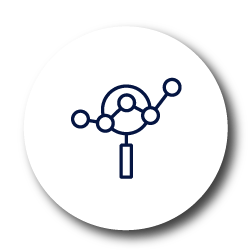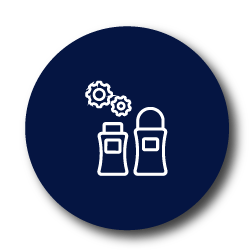So you want to make sure that your business performs to its full potential and are exploring category management best practices to ensure that. Do you know what these best practices are? Do you know how to implement them? More importantly, do you know what their impact may be on your business?
When implementing a category management solution, you must consider its best practices. That's what you'll find in this article. We unpack a handful of best practices, explore the benefits they can have on your business, and consider the consequences, should you not consider them.
About the contributors
Chrystle-Dee Gray joined DotActiv in 2019 as a senior space planner, working on the Pick n Pay account. She was appointed as an assortment analyst for GMD where she created and maintained the ranges. She has since expanded her role to work on the Dis-Chem account.
Meagan Paynee joined DotActiv in 2019 as a senior space planner, creating data-driven planograms for Ultra Liquors stores across South Africa.She has a BSc in Biological Science, as well as BConsumer Science: Clothing Retail Management from the University of Pretoria.
Tayla Grifo joined DotActiv in 2016 as a retail space planner. She has worked on various accounts, including Pick n Pay. In 2020, she was promoted to the newly established Software Account Management team where she oversees various software accounts.

You need accurate data
Data is the first and most important step in the category management process. It's also the link that ties together each aspect of the category management process. And to make sure that best practice is followed, you need to ensure that your data is accurate.
Why?
With accurate data, you can confidently make major decisions within your business, placing strategies and category management processes in place, which will drive up your overall sales, and therefore profit.
In a case where you work with inaccurate data, you could face many potential problems.
For example, without accurate data, you could end up with misclassified products and skewed sales. The knock-on effect would affect every single aspect of your store from your reporting to your floor plans, planograms and assortments.
What data must you consider?
With an understanding of why data is important, let's now explore which data fields are considered to be best practice.
Data Analysis should be standardised, so you should work with a list of unchanging fields relevant to your business such as barcode or product ID, product description, product size and UOM, brand, sales, units, period, store code, store name, regional details, and cluster (if applicable).
When collecting data, you also need to consider data that would be relevant to every step of the category management process, such as product images, product and fixture dimensions, and store specifications.
Without this data, it would be impossible for you to create accurate planograms and floor plans.

You need to consider clustering
Clustering is considered another category management best practice. However, it’s worth pointing out that this is only for retailers where it is necessary such as retailers with many different store locations, sizes and serving different customer demographics. It’s a critical step as it will allow you to streamline your assortment maintenance and planogram generation processes.
You can create clusters by grouping stores according to their similar attributes such as region, customer LSM, and store size. By creating clusters, you can also standardise your ranges, making sure that the shopper has a pleasant shopping experience in a store where all their needs are met, while the store is not overstocked with products that are not bought by customers of that demographic, which can lead to excess inventory and inefficient utilisation of the available selling space.
One of the major benefits of clustering is creating consistency, where stores can share similar assortments. Thus, when a shopper enters any store, regardless of where it is located, there is a feeling of familiarity and they can experience a consistent shopping experience throughout.
Should your business consider clustering?
Clustering is important for many reasons, which we have already explored, but is it relevant to every retailer? More specifically, is it relevant to you?
The main point to consider here is the size of your retail business. If you are a large retailer with many stores across many locations, clustering is something that you should consider as a category management best practice.
When you have multiple stores of different sizes that fall into different regions with customers of different LSMs, you can streamline your assortments and ensure that the correct products are being supplied to the stores where they are needed.
If you are a smaller retail chain, you may not need to create clusters. If there are only a small number of stores to tend to, it might be more beneficial to create store-specific assortments and planograms.

You need to consider floor planning
So you have accurate data and you have set up your clusters, but what comes next? Creating a floor plan is an essential part of the category management process, and is considered a key best practice.
Floor planning is the first step of the category management process in which a visual aid is used to implement your strategy. A data-driven plan of your store will show you how the store should be merchandised in a way that can promote category growth across all departments.
When you build a floor plan, you can allocate the correct space to each category within your store based on sales and trading density.
Should your business consider floor planning?
Absolutely! Floor planning is a category management best practice and is relevant to all retailers regardless of the number of stores, store size, or type.
For example, if you are a small retailer that only has 20 categories and 40 drops available in one store, floor planning will be able to help you take those 20 categories and allocate them according to the 40 drops available based on sales and trading density.
A floor plan should be created and implemented when you are opening a new store, revamping your current store or changing your strategy.

You need to consider assortment planning
The next step of the category management process is assortment planning. You should consider this as a best practice since there are many benefits your business will see from correctly executed assortment planning.
Assortment planning highlights key characteristics by which products are grouped based on the targeted market.
In doing this, you can create a framework by which you can assign products that best align the identified characteristics of the market. Once you create your assortments, you can save time by making ranging decisions based on accurate data and ensure that your stores receive the correct ranges. You can also ensure that accurate planograms can be built.
So what can go wrong if you do not use assortment planning as a best practice?
Offering the wrong products to your customers will result in poor stock holding as well as a loss of competitive edge, which will lead to decreased customer loyalty. Your cash flow could become tied up in the wrong products or brands. Also, your store will become cluttered and overstocked, which will limit the amount of differentiation of products.
Overall, without assortment planning, you run the risk of stocking products that don't appeal to the market they are servicing and end up with cash tied up in inventory that does not sell leading to customer dissatisfaction.
For example, if a product is out of stock and there are no transferable products available due to space constraints, a customer will go elsewhere in search of that product. This could further result in losing out on the sales of the other products that the shopper might have purchased in your store.

You need to consider planograms
Planograms are the last item to check off of your list of category management best practices.
Building a planogram is one of the final steps that will ensure what you have decided will be best for your category is actioned at a store level.
Planograms are a visual representation of your range, and a plan for how that range should be merchandised in-store. Through correct planograms, you can ensure that shelf space is effectively utilised and a pleasant shopping experience has been created for your customers.
Through the use of data-driven planograms, you can also ensure that your top selling lines are given the space they deserve, therefore creating category sales growth.
What do you need to build accurate planograms?
This is the step in which we see each previous step of the category management process link together. To build a planogram, there are a few things you will need first:
You will need the correct product and sales data, so that you can build a data-driven planogram and make informed merchandising decisions. You will also need fixture specifications and the number of drops assigned to each category on the floor plan.
You will need your pre-approved merchandising principles which have been discussed with the category specialist. You will need the range of products which should be merchandised in the planogram.
And of course, you will need the images and dimensions of every product displayed on your planogram.
Conclusion
If you want to make sure that your stores are successful, there are clearly defined category management best practices which you should apply to every step of your business processes. But remember - it’s not enough to just complete each of these steps. You have to make sure each one is implemented so that you will be able to measure your success.
Looking for advice or need a category management solution that can help your business? Visit our online store here for more information or book a custom exploratory consultation.


